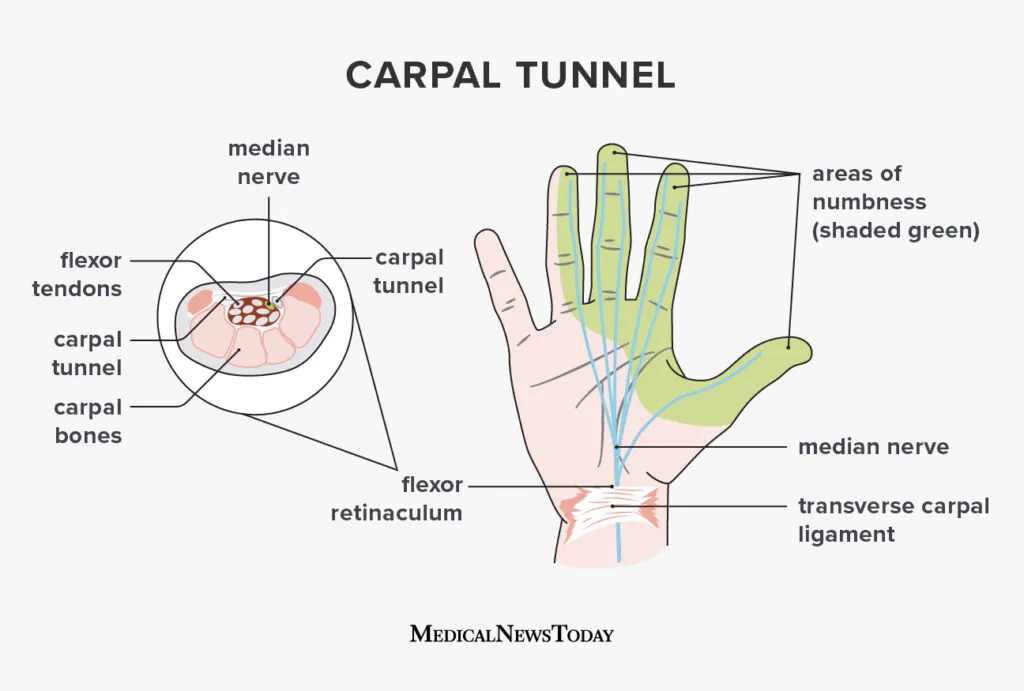Carpal tunnel syndrome (CTS) is a common condition that affects the wrist and hand. It occurs when the median nerve, which runs from your forearm into the palm, becomes compressed at the wrist. This compression often leads to discomfort and can limit the functionality of the hand over time.
In this article, we’ll cover the basics of carpal tunnel syndrome, how it’s caused, and the potential severity of the injury, especially in work-related settings.
What Is Carpal Tunnel Syndrome?
Carpal tunnel syndrome is a medical condition that occurs when the median nerve, which controls sensation and movement in the thumb and first three fingers, gets compressed. This compression happens in the carpal tunnel, a narrow passageway on the palm side of the wrist, formed by bones and ligaments. When this nerve is pinched, it can cause numbness, tingling, and pain in the hand and arm.
Key Symptoms of Carpal Tunnel Syndrome:
- Numbness and Tingling: Usually affecting the thumb, index, middle, and part of the ring finger. It may feel like your hand is “asleep.”
- Weakness: A weakened grip or difficulty holding objects is a common symptom.
- Pain: Persistent pain in the wrist or forearm, which might worsen at night.
- Loss of Sensation: In severe cases, there can be a complete loss of feeling in the fingers.
What Causes Carpal Tunnel Syndrome?
Carpal tunnel syndrome is typically caused by increased pressure on the median nerve and tendons within the carpal tunnel. Several factors contribute to this, including repetitive hand movements and certain medical conditions. Below are some of the most common causes:
Repetitive Motion Injuries
One of the leading causes of carpal tunnel syndrome is repetitive hand and wrist motions, often related to work activities. Jobs that involve continuous typing, assembly line work, or the use of vibrating tools can lead to overuse of the wrist, contributing to nerve compression.
Medical Conditions
Certain medical conditions can also raise the risk of developing carpal tunnel syndrome, such as:
- Diabetes: This can cause nerve damage, making individuals more prone to CTS.
- Rheumatoid Arthritis: Inflammation from arthritis can narrow the carpal tunnel, increasing pressure on the median nerve.
- Hypothyroidism: An underactive thyroid can cause fluid retention and swelling, leading to compression of the nerve.
Wrist Anatomy and Injuries
The size of your carpal tunnel and any previous wrist injuries can also affect your likelihood of developing CTS. Individuals with naturally smaller carpal tunnels or who have sustained wrist fractures are more at risk of nerve compression.
How Work-Related Activities Contribute to Carpal Tunnel Syndrome
Work-related activities are often associated with a higher risk of developing carpal tunnel syndrome, especially in jobs that require repetitive wrist movements or constant use of the hands. Many workers, from office employees to factory workers, may be at risk.
Office Work
Office workers who spend long hours typing or using a computer mouse can develop carpal tunnel syndrome from the repetitive hand and wrist movements. Prolonged use of the keyboard without proper ergonomics, such as poor wrist positioning or inadequate breaks, can put extra strain on the median nerve.
Manual Labor
Workers who use hand tools, especially vibrating ones like drills or jackhammers, are more susceptible to CTS. These tools can cause inflammation in the tendons and ligaments of the wrist, increasing pressure on the median nerve.
Assembly Line Workers
Jobs that require the same hand movements over long periods, such as packaging or assembling products, can lead to repetitive strain on the wrist. This repetitive stress is a major contributor to carpal tunnel syndrome among factory workers.
How Bad Can Carpal Tunnel Syndrome Get?
Carpal tunnel syndrome can range in severity, from mild discomfort to debilitating pain and dysfunction. In early stages, the symptoms are usually intermittent, but as the condition worsens, they can become constant and more severe.
Mild to Moderate CTS
In the early stages, you may experience occasional numbness and tingling in the fingers, especially at night. There may also be some discomfort in the wrist, but it usually goes away with rest or after shaking out the hand.
Severe CTS
In more advanced stages, carpal tunnel syndrome can cause chronic pain, muscle weakness, and significant loss of grip strength. Some people may lose the ability to properly pinch or hold small objects. In severe cases, the muscles at the base of the thumb can waste away, leading to permanent loss of function in the hand.
If untreated, carpal tunnel syndrome can cause permanent nerve damage, making daily tasks like holding a phone or typing difficult and painful.
Preventing Carpal Tunnel Syndrome at Work
Preventing carpal tunnel syndrome is particularly important for people whose jobs require repetitive hand and wrist movements. Taking the following steps can reduce the risk of developing the condition:
- Ergonomic Workstations: Adjust your desk, chair, and computer so that your wrists remain in a neutral position. Use wrist rests if necessary.
- Take Frequent Breaks: Taking short breaks from repetitive tasks can help relieve pressure on the median nerve.
- Stretching Exercises: Regular hand and wrist stretches can improve flexibility and circulation, reducing the risk of injury.
- Proper Equipment Use: Ensure that tools, especially vibrating ones, are ergonomically designed and that you are using proper form when working.
Treatment Options for Carpal Tunnel Syndrome
If you’re already experiencing symptoms of carpal tunnel syndrome, there are several treatments that may help reduce discomfort and improve hand function.
Non-Surgical Treatments
- Wrist Splints: Wearing a splint can help keep your wrist in a neutral position, especially during sleep, reducing pressure on the nerve.
- Anti-inflammatory Medications: Over-the-counter anti-inflammatory drugs like ibuprofen can reduce swelling and alleviate symptoms.
- Steroid Injections: In some cases, corticosteroid injections may be recommended to reduce inflammation around the nerve.
Surgical Intervention
In severe cases, when non-surgical methods don’t provide relief, surgery may be necessary. The most common surgical procedure for carpal tunnel syndrome is a carpal tunnel release. This involves cutting the ligament that forms the roof of the carpal tunnel to reduce pressure on the median nerve.
When to See a Doctor
If you experience persistent numbness, tingling, or pain in your hands that worsens over time, it may be time to see a doctor. Early diagnosis and treatment can help prevent long-term damage and restore proper function to your wrist and hand.
Doctors may perform tests like a nerve conduction study or electromyography (EMG) to diagnose the severity of the condition and recommend appropriate treatments.

